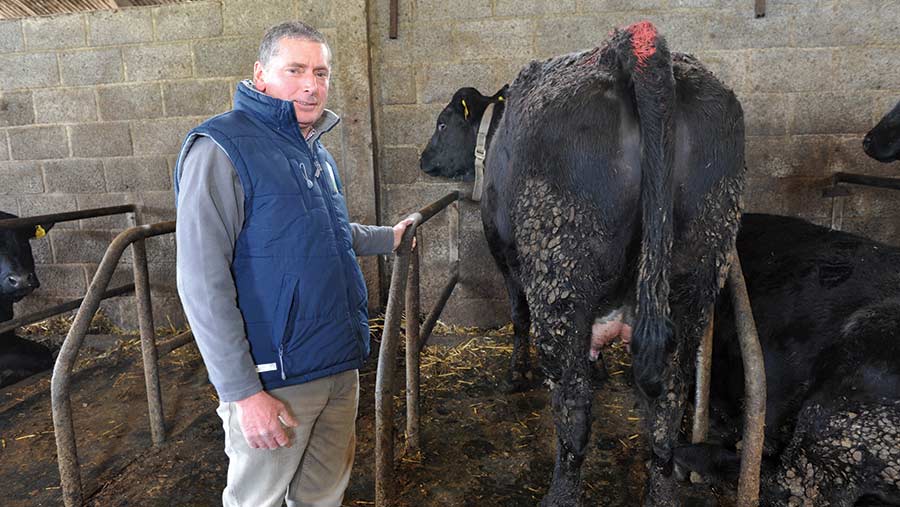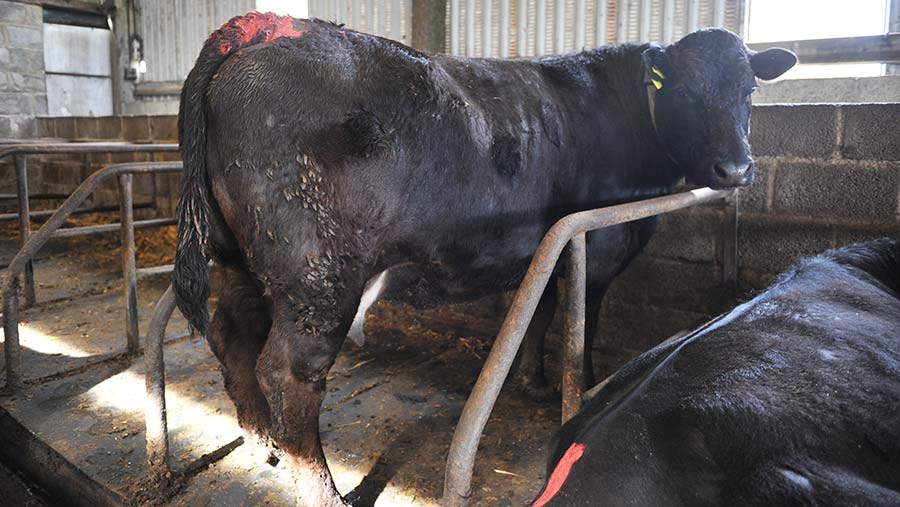AI helps beef herd reduce age at first calving

Artificial insemination is allowing a commercial suckler beef enterprise to calve heifers at 24 months – a year earlier than was possible when only stock bulls were used for breeding.
Philip and Shân Jones first turned to AI in 2013 to increase black Limousin cow numbers. They had already been operating a closed-herd policy for three years in an attempt to eradicate BVD and, as a result, had insufficient replacements.
“At the time we had a Limousin bull and three Charolais bulls. Even if we had been lucky and had had heifers from half the cows served by the Limousin, that would have given us only 12 or 13 without taking losses into account,” explains Mr Jones, who farms at Lan Farm near Cynwyl Elfed, Carmarthenshire.
“Our cows were getting older but we couldn’t buy in cows and calves because of our closed-herd policy. AI was our next port of call.”
See also: Step-by-step guide to using AI in your spring-calving herd
The Joneses are now in the third year of using AI on a third of their herd and are achieving a conception rate of 78% from 1.3 straws.
“By using better genetics and high Estimated Breeding Values, we are getting progeny that are achieving higher daily liveweight gains. This means we can now achieve our target 65% of mature weight at bulling, which in our case is 390kg.
“Our genetics have improved so much three years down the line that we are now calving our heifers at two years instead of three years.”
Shaky start
Mr Jones admits the system got off to a shaky start. In the first year, against advice, he used sexed semen on his cows. As an organic producer, certification body rules precluded synchronisation. “I was advised the conception rates on cows would not be as good as for heifers but, me being me, I didn’t listen.”
AI was used on 40 cows, split into two groups. Sexed semen was used on one group; conventional semen on the other. The herd was served for eight weeks in June and July.

“We had no luck in the first cycle with the sexed-semen group and didn’t do much better on the second. We switched to conventional semen on the third cycle and things got better,” Mr Jones recalls. An average conception rate of 47% was achieved from three cycles.
In the second breeding season, only conventional semen from a single black Limousin bull was used. The system was altered to run the AI group as a single group of 30 to make it easier to bring the animals in for serving.
The 30 cows selected were the first to have calved that year and included 15 that had been inseminated the previous year. Those animals were quieter and this influenced the behaviour of the other 15.
By selecting animals that had calved at a similar time, it also meant calves were at a similar age. “This helps with management jobs such as castrating and dehorning later in the year so there are labour savings,” he adds.
Improvements
In that second year, managing grassland to match an AI system had improved also. Mr Jones admits that in 2013 he had grazed fields in the wrong order. “I have learned to graze the fields further from the yard first and to work my way back to the yard. This allows me to build up grass for that eight-week period and means we always have a grazing platform in readiness for breeding.’’
Conception rates improved in 2014, from 47% from three straws of semen to 75% from 1.3 straws.
The same system was used in the 2015 breeding season but with one change – only black-coated Limousin cows were selected. A conception rate of 78% was achieved, again from 1.3 straws, but there was a reason for this. “We were being more thorough. If the technician served a cow and thought it was perhaps a bit early, he served her again the following day. In doing so we gained 3% on our conception rate,’’ explains Mr Jones.
After eight weeks of AI, a Charolais sweeper bull runs with the herd for four weeks.
Selecting bulls for AI
Before AI was used, terminal sires were selected but this has switched to sires with maternal traits.
“There had been an emphasis on muscle and beef but the priorities in EBVs are now calving ease, milkiness and calving ease in female offspring,” says Mr Jones.
He settled on a black Limousin because they have good maternal traits but the one downside is that the genetic pool is smaller.
AI technician
Mr Jones uses the Genus RMS seasonal system. The technician visits the farm every day at 9am. The service costs between £35 and £40 a head, depending on cow numbers, excluding semen. “It costs me £1,200 a year which works out at £20 a day. For that I get a technician here at the same time every day. I don’t know anyone else who would turn up on the yard with their own tools and van for £20 a day,’’ says Mr Jones.
Philip Jones’s advice to commercial beef farmers considering AI
- Do your research. “We spent hours researching our bulls even though the pool was small.”
- Don’t put pressure on yourself, the technician or the animal to achieve target conception rates. A 78% conception rate will not happen overnight.
- Call the vet in sooner rather than later if the cows don’t cycle in the first 21 days.
- Good/safe handling facilities are a must.
Cows are served from 1 June and if a cow hasn’t cycled by 22 June, she is given a veterinary examination the following day. “Sometimes they need assistance to get them going and at that stage we can do this,’’ says Mr Jones.
He is surprised how well the cows adapt to coming in to be served. “In the first few days we have some fun getting them in but after a week they come in of their own accord. The calves go towards the creep areas and the cows to their shed.’’
This season, AI will be used on a third of the 100 cows due to be bulled. AI isn’t used on heifers because these are calved a month earlier, in March, and there are insufficient numbers to make it cost-effective. But this could change soon. “As our numbers have increased we are nearly there and considering it.”
He says the reason the entire herd isn’t inseminated artificially is that the land around the yard is too wet to support greater numbers at breeding time.
Mr Jones believes there is always a place for a bull on the farm, but adds: “My ideal scenario would be to have two groups of 40 cows on AI and the other running with a bull. Sometimes you need time off to go on holiday.”
Benefits of AI
Rapid genetic improvement is the principal reason why many commercial beef farmers opt for AI, according to vet Michael Wilkinson, of Nantwich Farm Vets, Cheshire. “Visit any beef pedigree sale and there will be bulls selling for tens of thousands of pounds, which is beyond the reach of most commercial beef farmers. With artificial insemination they have access to those bulls’ genetics,” says Mr Wilkinson.
But he admits that artificially inseminating beef cows does present challenges. “Beef cattle can be more flighty than dairy cows so chalking animals, for example, to detect heat may be a struggle without the correct facilities.’’
He advises using monitoring devices that detect spikes in activity as another good means of heat detection for beef cattle, although these can be cost-prohibitive for smaller herds.
However, because beef animals usually show signs of heat more clearly compared with dairy cows, and have less metabolic pressures, he says a 60-70% conception rate can be expected with AI if done well.
“Make sure AI is done at the right time – 12 hours after the first signs of heat – although if animals are being brought in only once a day, inseminating earlier is better than too late,” Mr Wilkinson recommends.
He says a further two good reasons for using AI in beef herds are disease prevention and safety. “You can’t overlook the dangers that come with having bulls on the farm.”
